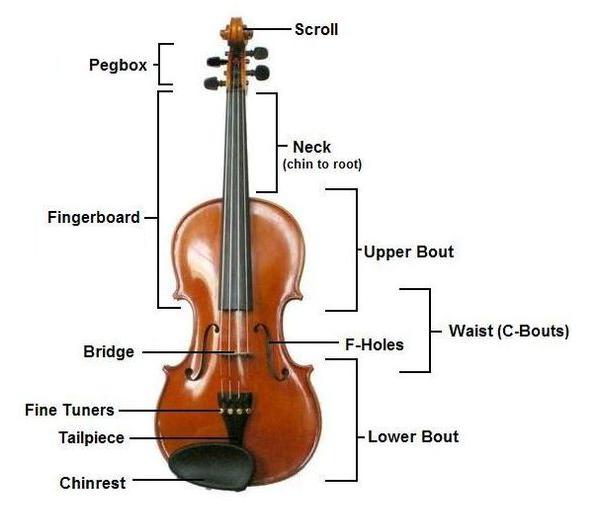A violin typically consists of a spruce top (the soundboard, also known as the top plate, table, or belly), maple ribs and back, two endblocks, a neck, a bridge, a soundpost, four strings, and various fittings, optionally including a chinrest, which may attach directly over, or to the left of, the tailpiece. A distinctive feature of a violin body is its "hourglass" shape and the arching of its top and back. The hourglass shape comprises two upper bouts, two lower bouts, and two concave C-bouts at the "waist," providing clearance for the bow.
The "voice" of a violin depends on its shape, the wood it is made from, the graduation (the thickness profile) of both the top and back, and the varnish which coats its outside surface. The varnish and especially the wood continue to improve with age, making the fixed supply of old violins much sought-after.
All parts of the instrument which are glued together are done so using animal hide glue, a traditional strong water-based adhesive that is reversible, as glued joints can be disassembled if needed. Weaker, diluted glue is usually used to fasten the top to the ribs, and the nut to the fingerboard, since common repairs involve removing these parts.
The purfling running around the edge of the spruce top provides some protection against cracks originating at the edge. It also allows the top to flex more independently of the rib structure. Painted-on faux purfling on the top is a sign of an inferior instrument. The back and ribs are typically made of maple, most often with a matching striped figure, referred to as "flame," "fiddleback" or "tiger stripe"
against cracks originating at the edge. It also allows the top to flex more independently of the rib structure. Painted-on faux purfling on the top is a sign of an inferior instrument. The back and ribs are typically made of maple, most often with a matching striped figure, referred to as "flame," "fiddleback" or "tiger stripe"
The neck is usually maple with a flamed figure compatible with that of the ribs and back. It carries the fingerboard, typically made of ebony, but often some other wood stained or painted black. Ebony is the preferred material because of its hardness, beauty, and superior resistance to wear. Fingerboards are dressed to a particular transverse curve, and have a small lengthwise "scoop," or concavity, slightly more pronounced on the lower strings, especially when meant for gut or synthetic strings.
Some old violins (and some made to appear old) have a grafted scroll, evidenced by a glue joint between the pegbox and neck. Many authentic old instruments have had their necks reset to a slightly increased angle, and lengthened by about a centimeter. The neck graft allows the original scroll to be kept with a Baroque violin when bringing its neck into conformance with modern standards.
The "voice" of a violin depends on its shape, the wood it is made from, the graduation (the thickness profile) of both the top and back, and the varnish which coats its outside surface. The varnish and especially the wood continue to improve with age, making the fixed supply of old violins much sought-after.
All parts of the instrument which are glued together are done so using animal hide glue, a traditional strong water-based adhesive that is reversible, as glued joints can be disassembled if needed. Weaker, diluted glue is usually used to fasten the top to the ribs, and the nut to the fingerboard, since common repairs involve removing these parts.
The purfling running around the edge of the spruce top provides some protection
The neck is usually maple with a flamed figure compatible with that of the ribs and back. It carries the fingerboard, typically made of ebony, but often some other wood stained or painted black. Ebony is the preferred material because of its hardness, beauty, and superior resistance to wear. Fingerboards are dressed to a particular transverse curve, and have a small lengthwise "scoop," or concavity, slightly more pronounced on the lower strings, especially when meant for gut or synthetic strings.
Some old violins (and some made to appear old) have a grafted scroll, evidenced by a glue joint between the pegbox and neck. Many authentic old instruments have had their necks reset to a slightly increased angle, and lengthened by about a centimeter. The neck graft allows the original scroll to be kept with a Baroque violin when bringing its neck into conformance with modern standards.
The bridge is a precisely cut piece of maple that forms the lower anchor point of the vibrating length of the strings and transmits the vibration of the strings to the body of the instrument. Its top curve holds the strings at the proper height from the fingerboard in an arc, allowing each to be sounded separately by the bow. The sound post, or "soul post," fits precisely inside the instrument between the back and top, below the treble foot of the bridge, which it helps support. It also transmits vibrations between the top and the back of the instrument.
The tailpiece anchors the strings to the lower bout of the violin by means of the tailgut, which loops around an ebony button called the tailpin (sometimes confusingly called "endpin" like the cello's spike), which fits into a tapered hole in the bottom block. Very often the E string will have a fine tuning lever worked by a small screw turned by the fingers. Fine tuners may also be applied to the other strings, especially on a student instrument, and are sometimes built into the tailpiece.
At the scroll end, the strings wind around the tuning pegs in the pegbox. Strings usually have a colored silk wrapping at both ends, for identification and to provide friction against the pegs. The tapered pegs allow friction to be increased or decreased by the player applying appropriate pressure along the axis of the peg while turning it.
The tailpiece anchors the strings to the lower bout of the violin by means of the tailgut, which loops around an ebony button called the tailpin (sometimes confusingly called "endpin" like the cello's spike), which fits into a tapered hole in the bottom block. Very often the E string will have a fine tuning lever worked by a small screw turned by the fingers. Fine tuners may also be applied to the other strings, especially on a student instrument, and are sometimes built into the tailpiece.
At the scroll end, the strings wind around the tuning pegs in the pegbox. Strings usually have a colored silk wrapping at both ends, for identification and to provide friction against the pegs. The tapered pegs allow friction to be increased or decreased by the player applying appropriate pressure along the axis of the peg while turning it.
Strings
Strings were first made of sheep gut (commonly known as catgut), stretched, dried and twisted. Modern strings may be gut, solid steel, stranded steel, or various synthetic materials, wound with various metals. Most E strings are unwound, either plain or gold-plated steel.
Violinists often carry replacement strings with their instruments to have one available in case a string breaks. Strings have a limited lifetime; apart from obvious things, such as the winding of a string coming undone from wear, a player will generally change a string when it no longer plays "true," with a negative effect on intonation, or when it loses the desired tone. The longevity of a string depends on how much and how intensely one plays.
Pitch range
The compass of the violin is from G3 (G below middle C) to C8 (the highest note of the modern piano.) The top notes, however, are often produced by natural or artificial harmonics.
Acoustics
Main article: Sound production (string instruments)
The arched shape, the thickness of the wood, and its physical qualities govern the sound of a violin. Patterns of the nodes made by sand or glitter sprinkled on the plates with the plate vibrated at certain frequencies, called "Chladni patterns," are occasionally used by luthiers to verify their work before assembling the instrument.
Sizes
Children typically use smaller string instruments than adults. Violins are made in so-called "fractional" sizes for young students: Apart from full-size (4/4) violins, 3/4, 1/2, 1/4, 1/8, 1/10, 1/16, and even 1/32-sized instruments exist. Extremely small sizes were developed, along with the Suzuki program, for violin students as young as 3. Finely-made fractional sized violins, especially smaller than 1/2 size, are extremely rare or nonexistent. Such small instruments are typically intended for beginners needing a rugged violin, and whose rudimentary technique does not justify the expense of a more carefully made one.
These fractional sizes have nothing to do with the actual dimensions of an instrument; in other words, a 3/4-sized instrument is not three-quarters the length of a full size instrument. The body length (not including the neck) of a "full-size" or 4/4 violin is about 14 inches (35 cm), smaller in some 17th century models. A 3/4 violin is about 13 inches (33 cm), and a 1/2 size is approximately 12 inches (30 cm). With the violin's closest family member, the viola, size is specified as body length in inches or centimeters rather than fractional sizes. A "full-size" viola averages 16 inches (40 cm).
Occasionally, an adult with a small frame may use a so-called "7/8" size violin instead of a full-size instrument. Sometimes called a "lady's violin", these instruments are slightly shorter than a full size violin, but tend to be high-quality instruments capable of producing a sound that is comparable to fine full size violins.
Violin sizes are not standardized and dimensions vary slightly between makers.




this is an nice instrument
RăspundețiȘtergereIt is a nice post. I like the music played at a violin. Sounds so.... beautiful. Good job. Keep doing this.
RăspundețiȘtergere